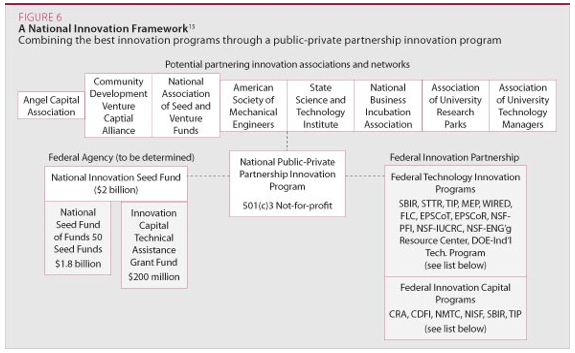
In a recent article1, we investigate the new American dynamic in regards to innovation. We are particularly interested in the article « Creating a National Innovation Framework », published in « Science Progress », which proposed a new system of governance of innovation by the American federal government. However, we wanted to know more – so the Mission for Science and Technology (Boston Section) contacted one of the article’s authors, Mr. Richard Bendis, to ask him a few questions. The phone interview took place on October 27th, 2009.
M. Richard Bendis is a recognized expert, as an entrepreneur as well as Director of Enterprise. He is the Founding President of « Innovation America (IA) », after having created and presided over « Innovation Philadelphia (IP) ». Mr. Bendis also developed activities for risk capital. It is within this realm that he serves as Vice Chairman of the “National Association of Seed and Venture Funds”, (NASVF). Mr. Bendis is also very well known in the United States for his investment banking firm, the “Bendis Investment Group LLC” (BIG). Adding to his various activities in the U.S., he is also an international lecturer and consultant (United Nations, NATO, European Commission, etc.) Finally, he has appeared in the weekly review “Federal Technology Watch.”
In this interview with Mr. Bendis (R.B.), the Mission for Science and Technology (MS&T) tried to discern if the new proposed system of innovation had a chance of being put into effect under the new administration. For the record, this new governance structures itself around a public-private partner dynamic, illustrated in the chart below:

Figure 1 : Model of Innovation Governance (reproduced with the consent of the authors)
MS&T: Your article attracted attention because it emphasized the possible changes and evolution of the politics of innovation conducted by the federal government. Considering that other similar initiatives have taken place in the past2, what is the origin of this document?
R.B : It started in 1995, under the Clinton administration, when the government had started to become interested in innovation. The new framework presented in the document (see chart) is not intended to be adopted in totality, but is designed to create a new dialog in Washington under the new federal administration.
MS&T : In your opinion, what are the chances that the federal government will be able to implement what you are describing regarding the new organization of innovation in the United States?
RB : The Obama administration needs to create a plan to support innovation directed towards economic recovery. For the new administration, the best way to do this is to attentively examine the existing programs in the domains of science, technology and innovation, because they form the backbone of the economy. As President Obama stated in his Innovation speech, the administration is convinced that supporting innovation and entrepreneurship is necessary for improving the economic conjuncture.
However, the political situations in Iraq and Afghanistan currently remain higher on the political agenda, as are health care reform, the economy and support for small businesses. It’s therefore a question of time, priorities, as well as political agenda.
MS&T : Don't you think an opportunity was missed to launch the reform that you talk about in your paper when the stimulus plan was debated and finally enacted by the legislature? Why did the plan opt for additional financial means for basic research through existing channels like NSF or DoE instead of providing more support for local clusters, innovation or support programs for small businesses?
R.B : I agree, it is disappointing. The stimulus plan did not pay enough attention to innovation, entrepreneurship and technology transfer as a means of stimulating the economy.
MS&T : Examining the Stimulus Plan, we have the impression that innovation is supported more by the states and local authorities, and that the federal government is content with supporting basic research.
R.B : In the past, this has been true, it has been up to the states to develop clusters, programs, etc. But at this point, the states are facing serious budgetary restraints, which necessitate a partnership between various agents within the innovation field: states, the federal government, academia, enterprises, etc. The fact is that the early stage capital is no longer there, as investors now tend to place their funds in enterprises that are in more advanced stages of development. For this reason, the federal government must help fill the void.
MS&T : In the United States, if I understand correctly, sources of financing for innovation primarily come from the private sector – enterprises, risk capital companies, banks, Angel investors, etc. and not by states or the federal government. Do you think that this will change within the next few years?
R.B : In terms of change, it’s still the private sector that will continue to support innovation. However, there is more of a need to help entrepreneurs during their period of economic development, most notably while crossing the “valley of death”, where the United States loses the chance to develop innovative concepts and start-up enterprises. In the past, these same young companies would have found funding. It’s no longer the case today because investors are looking for higher returns on their investments, or more immediate and direct ways of influencing sales figures. For the record, venture capitalists currently invest only 4% of their funds (less than 1 billion dollars) in early stage companies, preferring to invest in companies that have reached a certain maturity, and are more likely to generate profits in the short term.
The United States now needs to support young start-up companies to pass the “valley of death” stage, a phase that is now insufficiently funded. This role could be carried out initially by the NISF and in cooperation with the NPPI « National Public-Private Partnership Innovation Program ».
M&T : Aneesh Chopra was named by the Obama administration as Chief Technology Officer. What do you think about this nomination, and what will be the consequences of this creation on the organization of innovation in the United States?
R.B : It’s an important nomination. However, the Obama administration must also name a National Innovation Advisor, as the term “technology” primarily refers to a product, while “innovation” includes processes, services, ecosystems, and collaborations as well as products. A National Innovation Advisor could better assess the gaps in Federal Innovation Portfolio that need to be addressed in the United States.
M&T : In your article, you estimate that it would be necessary for the National Innovation Seed Fund (NISF) to allocate about 2 billion dollars towards the support of pre-seed, seed funding, and start-ups. Do you think that this estimation would be sufficient for the implementation and continuation of the National Innovation Framework (NIF)?
RB : The role of the NISF was discussed with Obama transition team in charge of new small business funding, as a vehicle for early investing, and to create a network of the best early stage investors in the United States. The funds will be matched by local and state funding, and managed by professionals in innovation (angel funds, seed funds). NISF was designed to help – to make recommendations, get returns on investments, and create new jobs. The overall goal is therefore to increase connectivity and commercialization within the innovation field. Potential partners of the NISF Could be the Treasury, the SBA, the OMB, etc.
M&T: What are the innovation models that inspired your recommendations ? Do you benchmark international innovation systems, or just those in the United States?
R.B : I am especially inspired by the best practices in the United States. I am particularly interested in the “Benjamin Franklin Technology Partners Program”, which has been financing early stage entrepreneurs for over 27 years, and has created one job for each $11,000 invested. I also follow the example of the « Kansas Technology Enterprise Corporation (KTEC) », which emphasizes early stage funding and pubic technology partners. Abroad, I have worked with the Portuguese government, which developed the COTEC National Innovation System.
MS&T : Do you think the new framework that you are proposing would be able to address the challenges of energy and smart grid related issues?
R.B : The framework presents a partial solution. Venture capitalists are becoming interested in clean energy investments, but investments still remain insufficient.
Writers :
Antoine Mynard, This email address is being protected from spambots. You need JavaScript enabled to view it.
Lynda Inséqué, This email address is being protected from spambots. You need JavaScript enabled to view it.
Heidi Phelps (transcription et traduction), This email address is being protected from spambots. You need JavaScript enabled to view it.
Source
Richard Bendis, 10/27/2009
More information
« Creating a National Innovation Framework », Richard Bendis & Ethan Byler: Science Progress >> www.scienceprogress.org
Richard Bendis, « Innovation America » www.innovationamerica.us
Definitions:
NIF, National Innovation Framework
NISF, National Innovation Seed Fund funding
COTEC, portuguese not for profit business association that counts on the support of its associated companies and all agents of the National Innovation System (NIS) to accomplish its goals through the implementation of initiatives in a variety of areas.

